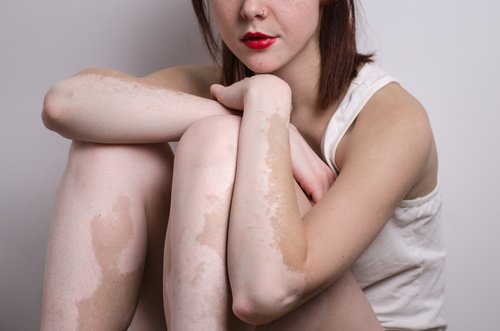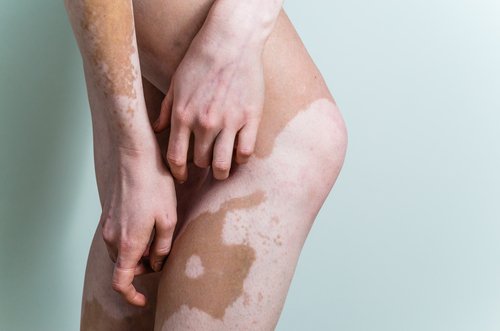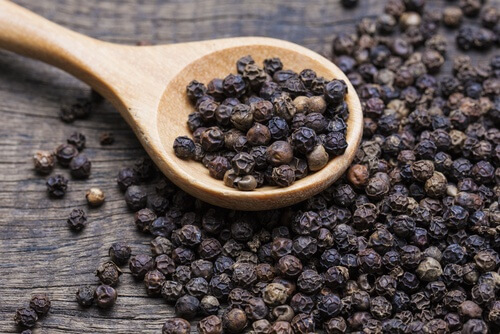Natural Remedies for Vitiligo

Vitiligo is a skin disease that’s caused by an immune system imbalance. When a person suffers from this disease, the cells that are responsible for their skin pigmentation are destroyed as if they were pathogens.
This causes the appearance of white spots or unpigmented areas of the skin. In today’s article, we’d like to talk some more about this condition and the natural remedies for vitiligo.
What you should know about vitiligo

This disease is characterized by the appearance of white or pale marks and spots on different parts of the body. These spots may spread or stay the same size. They usually appear on both sides of the body.
With vitiligo, the skin’s texture doesn’t change. It’s also not contagious. This condition is purely characterized by aesthetic and psychological impacts.
In almost half of the cases, the genetic predisposition to develop vitiligo is hereditary. However, it can be triggered by factors like hormonal changes, stress, or very serious health problems, for example.
Discover: 6 Natural Remedies That Prevent Autoimmune Diseases
There are two types of vitiligo:
Generalized
This is the most common form, which is characterized by the development of unpigmented lesions on both sides of the body in similar places. This type of vitiligo mainly affects:
- The face
- The fingers
- The underarms
- The knees
- The pelvis
There’s a tendency for lesions to appear in these areas because there are “borders” between two types of skin, such as the eyelids, the edges of the lips, the ears, etc.
Segmental

Natural remedies for vitiligo
There are some natural remedies for vitiligo that can help reduce the appearance of the blemishes or the risk of pigmentation loss. Some of the foods that can be helpful include:
Cucumber
Cucumber is one of the best natural remedies for vitiligo. This is because it’s packed with vitamins B and C. Also, it’s known for its moisturizing properties (which is why it’s found in so many commercial beauty treatments).
It helps whiten the dermis, reduce wrinkles, soften sensitive skin, and balance oily skin. It’s also recommended for those with psoriasis and vitiligo.
Basil

Read more here: The Incredible Medicinal Properties of Basil
To maximize the effects of basil, it’s a good idea to mix it with some lemon juice. However, you should keep in mind that it can take a few months to see results.
Kiwi
Thanks to its properties and nutritional makeup, kiwi is one of the best natural remedies for vitiligo. To take advantage of it, add kiwi to your daily diet.
You can eat a kiwi at breakfast, as a mid-morning snack, or as a dessert after lunch or dinner. Because it’s so delicious, you can add it to a smoothie with other fruits.
Kiwi boosts your body’s natural defenses and improves your immune system function. This means that it will reduce the chances of it attacking the cells that produce pigmentation.
Strawberries

This small and tasty fruit packs a lot of vitamins, including vitamin C, which is known for its antiviral and antibacterial properties. That’s why we recommend that you eat strawberries several times a week.
Chickpeas
This action-packed legume has lots of amino acids and vitamins that will reduce the chances of your body destroying the cells that are responsible for pigmentation. It also increases your melanin production.
You can consume chickpeas in a variety of dishes, including hummus, in soups, or in stews.
Black pepper

Ingredients
- 1 pinch of ground black pepper
- 1 teaspoon of extra virgin olive oil (5 g)
Preparation
- Place the black pepper in a bowl and pour the olive oil over it.
- Mix until you get a paste and apply it to any areas where you have white spots.
- Leave on for an hour and a half before rinsing with warm water.
- Repeat this at least twice a day for a month.
Papaya
This delicious tropical fruit is excellent for treating all kinds of skin conditions, including psoriasis and vitiligo.
To take advantage of its benefits, just cut open a piece of papaya and rub it on the affected areas. Repeat this every day before you go to sleep without rinsing.
In addition, drinking papaya juice or adding it to smoothies will also help with the process.
Red clay
You can buy this in naturalist stores and can even find it in river beds. Red clay provides a lot of copper, which helps restore pigmentation to white spots.
Ingredients
- 1 tablespoon of red clay (15 g)
- 1 tablespoon of grated ginger (10 g)
Preparation
- Add the clay to a bowl and mix in the grated ginger.
- Apply it to the affected area at least once a day.
- Leave on for two hours before rinsing with warm water.
- Repeat this every day for a month.
Give these great natural remedies for vitiligo a try today!
All cited sources were thoroughly reviewed by our team to ensure their quality, reliability, currency, and validity. The bibliography of this article was considered reliable and of academic or scientific accuracy.
- Fitzpatrick TB. (2014). Vitiligo treatments.
avrf.org/treatments-products/vitiligo-treatments.html - Mahesh S, et al. (2017). Homeopathic treatment of vitiligo: A report of fourteen cases. DOI:
10.12659/AJCR.905340 - Mayo Clinic Staff. (2017). Vitiligo.
mayoclinic.org/diseases-conditions/vitiligo/diagnosis-treatment/drc-20355916 - Parsad D, et al. (2003). Effectiveness of oral Ginkgo biloba in treating limited, slowly spreading vitiligo.
ncbi.nlm.nih.gov/pubmed/12780716
This text is provided for informational purposes only and does not replace consultation with a professional. If in doubt, consult your specialist.








